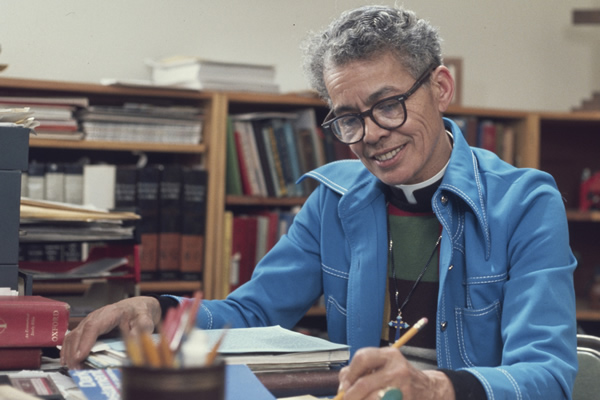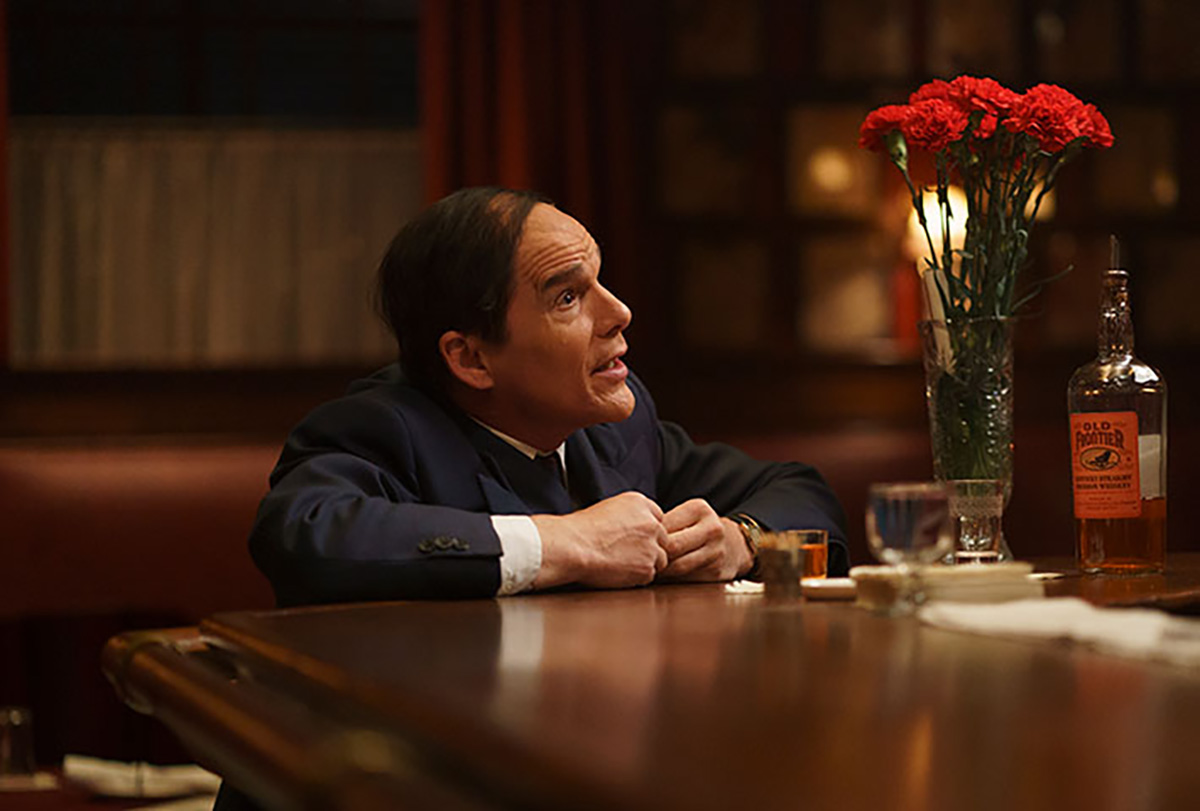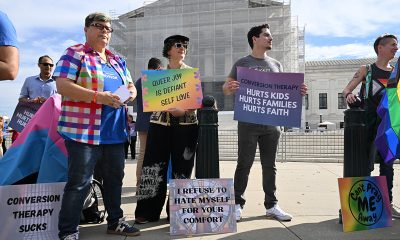Movies
Amazon Prime doc tells story of Black, queer civil rights pioneer
RBG quoted Anna Pauline (Pauli) Murray before Supreme Court

No one could have imagined the life of Anna Pauline (Pauli) Murray, the Black, queer, gender nonconforming civil rights pioneer who lived from 1910 to 1985.
Few people have done as much to make the world more just than Murray. Last year, Murray’s scholarship was used to help the ACLU successfully argue before the Supreme Court that Title VII of the Civil Rights Act of 1964 protects LGBTQ+ people from being fired in the workplace because of their sexual orientation and gender identity. Yet, many people don’t know who Murray was.
“My Name is Pauli Murray,” a new documentary playing in select theaters and streaming on Amazon Prime, tells the story of Murray’s fascinating life. The engrossing film is co-directed by Betsy West and Julie Cohen, who directed “RBG,” the popular documentary on Ruth Bader Ginsburg.
“RBG” is a good documentary. Yet, the 131-minutes-long “My Name is Pauli Murray” is even better.
Conveying the complexity of Murray’s life in a doc of that short length would fell many mortals. But West and Cohen are up to the task.
Using recordings of Murray’s voice; Murray’s letters, footage of everything from Murray with one of her dogs to Harlem in the 1930s along with interviews with Murray’s family and biographers, the film draws you into Murray’s world.
To say Murray was a Renaissance woman isn’t trite. Murray was a lawyer, poet, writer, activist and educator. That’s just the tip of the iceberg!
For decades, Murray and Eleanor Roosevelt were friends. Murray was a co-founder of the National Organization for Women. Gay writers James Baldwin and Langston Hughes were her writing buddies. Murray and Baldwin were the first Black writers to be invited to the distinguished MacDowell writing colony.
In her 60s, Murray left her tenured position teaching at Brandeis University to go to seminary. She became the first Black woman to be ordained a priest by the Episcopal Church.
It doesn’t stop there! A paper Murray wrote as a Howard Law School student was a key element of Thurgood Marshall’s strategy in overthrowing racial segregation in Brown v. Board of Education. Ruth Bader Ginsburg quoted Murray when she argued against sex discrimination before the Supreme Court.
While she was alive, Murray was closeted about much of her personal life. Murray had a decades-long relationship with Irene Barlow. But, because of the times in which she lived, Murray couldn’t be open about their relationship.
Murray felt that she was misgendered—like a man in a woman’s body. This, too, Murray kept secret.
In “My Name is Pauli Murray,” Murray’s family and biographers refer to Murray with the pronouns “she and her.” A non-binary activist refers to Murray as “they.”
Murray is having a much-deserved moment. In 2016, Yale University named one of its residential colleges after Murray. It was the first time a Yale college was named after a person of color or an (openly) LGBTQ+ person. In 1965, Murray was the first African American to graduate from Yale with a doctorate in judicial science.
In 2017, the National Park Service, part of the Department of the Interior, Murray’s family home in Durham, N.C., as a National Historic Landmark.
Watching, “My Name is Pauli Murray,” you’re bowled over by Murray’s resilience and achievements. Fifteen years before Rosa Parks, she protested racial segregation on buses.
“I’ve lived to see my lost causes found,” Murray says.
It’s hard to humanize an icon. But, the filmmakers don’t place Murray on Mount Olympus.
Even as a child, we learn, Murray wanted to wear pants. That was fine during the week, her Aunt Pauline said, but Murray would have to wear a dress to church on Sunday. Though, few understood Murray’s feelings, Aunt Pauline called Murray “my boy girl.”
Murray and Barlow never lived together. Yet, you get a sense of their intimacy from the letters they exchanged. They called each other “Linus” and “Charlie Brown” (characters in the Peanuts comic strip) and wrote of longing to “share” listening to Brahms’ Fourth Symphony and the New York Times crossroad puzzle.
“My Name is Pauli Murray” will leave you talking about Murray and how to honor her legacy. That would have made Murray happy.
Movies
Queer Broadway icon gets stellar biopic treatment in ‘Blue Moon’
Ethan Hawke delivers award-worthy performance as Lorenz Hart

Even if you’ve never heard the name Lorenz Hart, chances are high you’ve heard some of his songs.
A giant of early 20th century Broadway songwriting, he was a lyricist whose complex blend of wit and wistful romanticism – mostly set to music by longtime composing partner Richard Rodgers – became a significant part of the “Great American Songbook,” performed and recorded by countless musical artists in the decades since. Yet despite his success, happiness eluded him; depression and alcoholism eventually hobbled his career, and he died in 1943 – aged only 47 – from a case of pneumonia he caught after passing out in the rain in front of his favorite bar.
His tragic story might seem an odd fit for a screen treatment from maverick director Richard Linklater, but his latest film – “Blue Moon” in theaters as of Oct. 24 – delivers exactly that. It crafts a mostly speculative and highly stylized portrait of Hart (portrayed in a tour-de-force by longtime Linklater muse Ethan Hawke) on a night that was arguably the lowest point in his professional career: the opening night of “Oklahoma!” – the soon-to-be smash hit composed by Rodgers (Andrew Scott) with new partner Oscar Hammerstein III (Simon Delaney) after their two-decade partnership had been tanked by his personal struggles.
In Robert Kaplow’s theatrically crafted screenplay, Hart shows up early for the post-opening celebration – held, of course, at Broadway’s legendary meeting place, Sardi’s – to hold court with the bartender (Bobby Cannavale) and a young hired piano player (Jonah Lees) while steeling his nerves with a few shots of the whiskey he has sworn to avoid. He’s not there to support his old colleague, however; there’s too much resentment swirling inside him for that. Rather, he’s there to connect with 20-year-old college student Elizabeth (Margaret Qualley), whom he has taken on as a protege – and with whom he has convinced himself he is in love, despite the homosexual inclinations that are mostly an “open secret” within his circle of Broadway insiders.
Constructed as a real-time narrative that follows Hart over the course of the evening, Kaplow’s script could almost be described as a monologue – with interruptions, of course – by the songsmith himself; aided by Hawke’s fearlessly unsentimental performance, the film’s presentation of Hart – a queer man grappling with his own self-loathing in a deeply homophobic era – is almost brutal in its exploration of his emotional and psychological landscape. He has walked a thin line for most of his life, alternately hiding and flaunting his inner truth for decades to navigate his world, and the strain has taken its toll; once heralded as one of Broadway’s brightest talents, his reputation has been ravaged by rumor, and he occupies his time by escaping his loneliness through self-denial and liquor. He’s become that guy at the bar who regales you with larger-than-life stories while peppering them with barely concealed bitterness and regret; you can’t help but feel empathy for him, but you’d love to politely extract yourself from the situation at the first opportunity.
There’s something relatable about that situation – from both perspectives – and that’s what keeps “Blue Moon” from becoming insufferable. It’s the kind of movie that makes us cringe, not over the pathetic behavior of its leading character but in anticipation of the next uncomfortable development that’s sure to come as a consequence. He’s a seasoned raconteur, with a polished wit and a prodigious skill with language, and we find ourselves pulling for him both in spite and because of the sense of manic desperation we can feel behind his words.
It’s that almost-grudging empathy we feel for him that gives “Blue Moon” a sense of humanity in the face of what might otherwise seem a relentlessly bleak character study, and keeps us from judging Hart’s impulses toward self-delusion and self-destruction too harshly; and in the end, Linklater’s biopic leaves us with a perspective on his life that emphasizes the legacy he left behind – the poignant lyrics that bespoke an unfulfillable longing for love and connection – and the lasting influence he cast over the generations that succeeded him.
To underscore the latter, the movie imagines a few fortuitous encounters during the festivities at Sardi’s, in which Hart unknowingly drops nuggets of inspiration for such future icons as author E.B. White and a very young Stephen Sondheim. The meetings may or may not not be flights of fancy, but they convey the lasting impact of Hart’s creative contributions in a way that not only feels truthful in spirit but provides some amusing “Easter Egg” moments for buffs of Golden Age Broadway-and-Hollywood lore.
In fact, it should be said that “Blue Moon,” despite the underlying melancholy and the squirm-in-your-seat discomfort that hovers around its edges, is a thoroughly entertaining film; constructed like a play, shot in a style that evokes the cinema of the era (with ongoing references to “Casablanca” to underscore the connection), and wrapped in the nostalgic glow of old Manhattan in its elegant heyday, it bubbles with the kind of wryly sophisticated humor that marked so much of Hart’s own work and thrills us with the feelings it sparks within us as it goes.
For that, we must again point to Hawke’s award-worthy performance as the core element; though he accomplishes a physical transformation into the short-and-balding Hart, and masterfully captures his flamboyant personality, it’s the actor’s understanding of the songwriter’s inner landscape that gives the movie its heart, soul, and painfully human perspective.
Even so, it’s a movie with an entire cast’s worth of superb performances. There’s Scott’s carefully measured Rodgers, balancing genuine friendship with the frustrated impatience of navigating a strained relationship in public. Qualley walks a similar tightrope as the object of Hart’s misguided affections, charming us with authentic fondness and diplomatic compassion, and Cannavale provides a solid ground of streetwise wisdom as the bartender who might be his best friend. Patrick Kennedy’s E.B. White, bringing a welcome note of respect and insight, is also a standout.
Yet while the acting in “Blue Moon” may be excellent across the board, it’s Linklater’s direction that drives his cast’s work and ties it all together; a proven chameleon behind the camera, he embraces the theatrical structure of the screenplay with a perfectionist’s aesthetic, and indulges his fascination with time by encapsulating the portrait of a man’s entire life into the observations that can be gleaned from a single night. More importantly, perhaps, he honors his subject by refusing to define Hart’s sexuality to fit modern sensibilities. We can draw whatever conclusions we want, but in the end we have no reason to reject the songwriter’s description of himself as “ambi-sexual” – even though, with its undercurrent of jealousy between two ex-partners, it’s hard not to take note of some very gay implied subtext.
In the end, Hart’s sexual “label” is irrelevant; his loneliness is what matters, the longing to love – and to be loved – which we all share, regardless of our sexual makeup.
It’s the tragic beauty of that universal pang that comes through in all of the timeless lyrics that Lorenz Hart wrote, and it comes through in Linklater’s excellent movie, too.
Movies
Romero throws queer twist on father’s legacy with ‘Queens of the Dead’
Drag queens, trans women, femme boys, butch girls battling zombies

It may be hard to believe, but once upon a time, there weren’t really a lot of zombie movies.
Sure, zombies turned up from time to time during the classic era of horror movies, but in those days they were typically only the mindless slaves of a sinister master who has taken control of their consciousness and their will by means of arcane magic – a conception largely invented from racist tropes derived from the misinterpreted voodoo lore of Haiti and other colonized cultures of the Caribbean. These early zombies were not evil in themselves; they chased you because they were following orders, not because they wanted to eat your brains, and they were usually less scary than they were pitiable.
As any fan of horror knows, all that changed in 1968. That was the year that George A. Romero rewrote the playbook on zombies with his low-budget masterpiece, “Night of the Living Dead.” Gone were the shambling mind-controlled somnambulists that once defined them in the popular imagination, replaced instead with relentless walking corpses driven not by voodoo but by a primal and insatiable instinct to devour our flesh, and – perhaps worse – turn us into creatures just like them in the process.
Ever since then, the zombie subgenre has been a perennially popular staple of horror cinema, both through the sequels Romero himself would go on to create and the plentiful imitations and appropriations of generations of filmmakers inspired by him, and – like the creatures that inhabit it – just seems to keep going. Zombies are now a seemingly permanent fixture in our pop entertainment culture; indeed, there are so many movies and TV shows (and spinoffs) revolving around them that it’s easy to let a new one slip by without taking notice.
With “Queens of the Dead,” however, notice should be taken – because while there may be a lot of zombie movies out there already, this one comes from the daughter of the man who reinvented them, and with it, she puts her own unique mark on the family legacy.
A wild and campy ride through the nocturnal world of Brooklyn, Tina Romero’s “zom-com” centers on a group of drag queens and queer club kids in Brooklyn as they prepare for a massive warehouse party. Things are not going smoothly; mere hours ahead of showtime, show producer Dre (Katy O’Brian) is informed that the headliner, a social media-famous drag queen named Yasmine (Dominique Jackson), has cancelled, and the only possibility for a replacement is Sam (Jaquel Spivey) aka “Samonce” – who hasn’t performed since running out on her own sold-out show, years ago. Meanwhile, in the outside world, a sudden and unexplained plague of zombies has begun to spread, with the flesh-eating undead crowd growing larger by the minute; and when the doors open for showtime, Dre and their crew of queer-and-allied cohorts find themselves forced to overcome all the bickering, backbiting, and “frenemy” rivalries between them in order to survive as the club becomes ground zero in a zombie apocalypse.
Buoyed by an exceptional ensemble cast, Romero’s audacious feature takes her late father’s original formula – an unexplained and unrelenting epidemic of undead cannibals terrorizing a group of mismatched survivors as they try to plan their escape – and spins it into an irreverent, edgy, and deeply macabre comedy which feels almost as indebted to the underground countercultural “trash” cinema of John Waters as to her father’s iconic horror masterpiece, even though it has a slicker veneer than either. At the same time, she builds real relationships between the collection of characters she gathers together, making them all relatably human while also raising the emotional stakes for the horror drama that remains in play throughout and despite the humorous framework. It’s a balancing act that could easily go wrong, but “Queens of the Dead” pulls it off with a blend that takes itself just seriously enough to keep us on edge yet never too much so to kill the fun, offering up moments of genuine horror alongside scenes of absurdist camp without either feeling out of place.
What makes Romero’s twist on her father’s iconic film – for “Queens of the Dead” feels much like a “spiritual remake” at times – especially compelling is that she manages to keep all of its formulaic integrity intact while re-expressing it through an unapologetically queer lens. The characters are drag queens, trans women, femme boys, butch girls, lesbians, and yes, even a couple of cisgender heterosexuals. It’s a true “rainbow coalition” of a cast, thrown together to combat an onslaught on their community, and looking fabulous while they do it.
Of course, it’s impossible not to also recognize the thread of social commentary that connects Romero’s film to her father’s original, which, with its Black protagonist, evoked a powerful subtext about racism and mob violence. In “Queens,” she gives us the unmistakably direct allegory of watching a band of queer outsiders forced to fight back against a horde of mindless and malevolent drones, phone-obsessed zombies staring at their screens for distraction as they search for new victims to devour. At its heart, queer horror stories are always about this: the gnawing fear of the conforming masses, swayed by the lights and color and noise of their propaganda to target and terrorize, and even though she delivers it with a healthy touch of tongue-in-cheek humor, this one carries that message with absolute clarity.
Spivey (Broadway’s “A Strange Loop”) makes for an outstanding unlikely hero/heroine, and O’Brian brings a winning, sexy swagger as Dre. Quincy Dunn-Baker makes an impact as the club’s seemingly toxic straight handyman, and in addition to Jackson’s scene-stealing performances as diva Yasmine, there’s a superb supporting turn by Margaret Cho as a militant lesbian who unleashes her fury on the zombie hordes, along with a host of other memorable performances from such familiar and talented performers as Riki Lindhome, Jack Haven, Nina West, Tomas Matos, Eve Lindley and Cheyenne Jackson.
Entertaining, smart, and surprisingly light-hearted for all its zombie carnage, “Queens of the Dead” is one of those hidden gems of a movie that has all the earmarks of a cult classic. Opening in theaters on Oct. 24, it’s our best pick as your holiday must-see for the Halloween season.
Movies
Breakthrough queer performance makes for a memorable ‘Kiss’
Tonatiuh brings a sensitivity that illuminates other elements around him

When queer Argentine author and activist Manuel Puig published his novel “El beso de la mujer araña” in 1976, it’s doubtful he could have dreamed it would one day be turned into a musical. With most of the action taking place between two characters in a cramped prison cell, and a bleak political context casting dark shadows across even its brightest moments, it didn’t exactly seem a good fit for that kind of treatment. And besides, thanks to its open depiction of queer sexuality and the overtly revolutionary tone of its political messaging, he could barely even get it published.
A decade later, it had become a major Hollywood movie, winning an Academy Award for William Hurt; it had also caught the attention of John Kander and Fred Ebb, the composing team responsible for (among other hit musicals) “Cabaret” and “Chicago,” who joined with playwright Terrence McNally to craft an adaptation for the Broadway stage. The resulting show would debut there in 1993, winning seven Tonys and a host of other awards; Puig, sadly, did not live to see it, dying in 1990 of complications from surgery after a life lived mostly in exile over his queer activism and outspoken political beliefs.
Now, the musical incarnation of “Kiss of the Spider Woman” has finally made its way to the screen, courtesy of veteran filmmaker Bill Condon – who, besides his screen adaptations of “Dreamgirls” and “Chicago,” is also responsible for “Gods and Monsters” and the “Twilight” movie franchise – and starring Latina diva Jennifer Lopez in the title role.
For those unfamiliar with the piece, whether in its musical form or any of its earlier iterations, the story centers on the relationship between two cellmates in an Argentine prison – Valentin (Diego Luna), a revolutionary being held as a political prisoner, and Molina (Tonatiuh), a queer window dresser imprisoned for “public indecency” – with very little in common and even less to talk about. Nevertheless, a connection begins to form between them when Molina decides to pass the time between them by narrating the story of his favorite movie – a glossy old Hollywood musical romance starring his most beloved Golden Age star, Ingrid Luna (Lopez) – and Valentin is drawn in despite his disdain for Molina’s trivial interests and seeming lack of political conscience. As the days pass and Molina continues his narrative in installments, their forced cohabitation begins to deepen into an unlikely friendship – and maybe more.
Of course, there are dark secrets in play, too, hidden agendas and undisclosed truths that strain their trust between each other; nevertheless, as they continue to bond, through both the escapist fantasy of Molina’s ongoing cinematic “recap” and the harsh brutalities of their shared reality, they find an intimacy that helps them transcend their perceived differences in a place designed to crush both their humanity and their hope.
In Condon’s adaptation, the stage musical is reworked to bring it closer in tone, perhaps, to Puig’s original novel, emphasizing the contrast between the grim and colorless prison cell with the spectacular glitz and larger-than-life glamor that saturate the imagined world of Molina’s recounted movie – and it’s quite a contrast. In these sequences, “Kiss of the Spider Woman” opens up its claustrophobic setting into an elaborate recreation of glossy Hollywood escapism at its Technicolor peak, full of exquisitely staged scenes of romance, action, and Golden Age MGM-level musical choreography, which also permits the film’s two male stars to spread their creative wings even further, by casting them alongside Lopez as parallel characters in the “metafilm” fantasy where so much of the story’s emotional resonance occurs – and where many of the plot details begin to reflect their “real world” circumstances as it goes along. It’s all carried off with excellence, professionalism, and technical wizardry, and the result could easily be described as cinematic “eye candy” that’s sure to please fans of the musical genre.
Yet there’s something vaguely disappointing in the choice to differentiate the two worlds of “Spider Woman” so distinctly and completely. It creates a sense of watching two separate movies that have been spliced together, one a gritty story of oppression and survival and the other the other a wild and campy exercise in nostalgic Hollywood gloss. It’s an effective enough tactic, but what it misses is the blending that happens between the two worlds in the stage production, where fantasy and reality overlap and intertwine, and we can’t help wishing that Condon had taken a more imaginative approach, one that might have translated that magical theatricality to the screen in a uniquely cinematic way.
Still, the message comes across. The story’s deeper explorations emerge with eloquent clarity – of facing reality without sentiment or escaping it through fantasy, of bridging differences of attitude and perspective through human connection at its most basic level, and perhaps most crucially, of seeing beyond a limited understanding of sexuality and gender.
For that last point, there is no more direct reason for it than the performance of Tonatiuh. Seeing Molina embodied by a queer actor brings a level of sensitivity and truth to the mix that illuminates every other element around him. It’s a breathtaking leap toward stardom from a previously (mostly) unfamiliar performer, equally adept in the musical sequences as with the strictly dramatic material, and it elevates “Spider Woman” simply by being there.
His co-star is equally superb. Luna brings his own brand of sensitivity – and vulnerability – to Valentin; he’s also up to the demands of the musical scenes, going toe to toe with Lopez and a whole crew of dancers and seeming to enjoy every minute of it. Most important, he strikes a chemistry with Tonatiuh that makes their blossoming tenderness toward each other into the true saving grace in their character’s lives – the real world magic for which movie fantasies are only a metaphor – and lingers fondly in our memory long after the film is done.
As for Lopez, she claims the screen when she’s on it, bringing a commanding presence and a hard-working pro’s intensity to her multiple roles as Molina’s beloved actress, her character, and the sinister alter ego of the title. No, she’s not Chita Rivera (who could ever be?), but she’s more than up to the challenge of bringing her own distinct energy to make the part her own.
We can’t deny that “Spider Woman,” which began its theatrical release on Oct. 10, faces an obstacle as the screen adaptation of a popular piece of musical theater; fans of the original will doubtless have expectations going in, and opinions coming out, and there’s nothing to be done about that. While it might have benefitted from a more out-of-the-box handling of the show’s dual reality, what’s important is the purity and resonance of the queer voice that comes shining through it, not just in Tonatiuh’s soulful performance but in the movie’s essential core, and that’s worth more than enough to counter any nit-picky quibbles about its overall approach.
It may not please everyone, but thanks to its remarkable lead performances and the authenticity that illuminates both its drama and its fantasy, it’s got the kind of soft power that can stay with you forever.
-

 District of Columbia23 hours ago
District of Columbia23 hours ago‘Sandwich guy’ not guilty in assault case
-

 Sports1 day ago
Sports1 day agoGay speedskater racing toward a more inclusive future in sports
-

 Celebrity News3 days ago
Celebrity News3 days agoJonathan Bailey is People’s first openly gay ‘Sexiest Man Alive’
-

 Opinions4 days ago
Opinions4 days agoNew York City mayoral race gets nasty but Mamdani will win



















